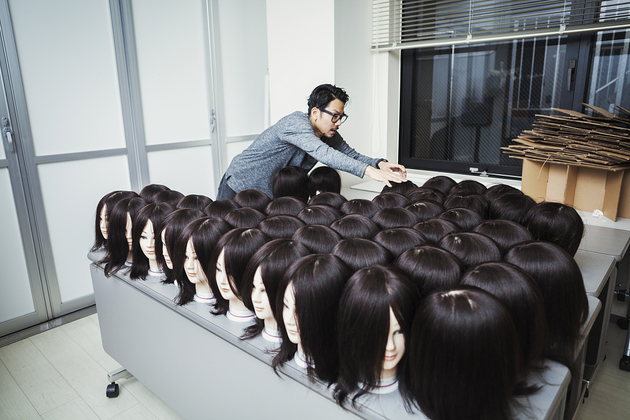Mar. 13 (NBD) – Li Yidi, who worked in Shanghai for a luxury brand as a social media marketing executive, decided to resign from his position with annual salary of over 400,000 yuan (59,600 U.S. dollars) and leave for Central China's Xuchang starting off the wig sales.
"Is selling wigs a lucrative business?" Doubtful and excited, Li accepted the job offer from a wig manufacturer in the city where tens of thousands of people are engaged in wig retailing on e-commerce platforms like Amazon and eBay.
The companies purchase fine quality human hair to make wigs. Their major target consumers are black people in the United States, Europe, Africa and other areas.
As the demands for wigs by black women are growing, firms in Xuchang gain a foothold in the global wig market.
The wigs range from weekly disposable wigs priced at dozens of U.S. dollars to hand-woven human hair wigs with prices of over 1,000 U.S. dollars, the scalp and sideburns of which are made of a dense lace web.

Photo/VCG
However, at first few black women know where their wigs actually came from.
Over a long period of time, wig sellers kept the origin of wigs a secret, only to stress that it was handmade with human hair from India or Vietnam.
Now, on Instagram and YouTube, more Chinese faces appear in videos detailing the workmanship of wigs and a large number of wigs on eBay are labeled "made in China".
The majority of those products are imported from Xuchang.
More than 5,000 wig workshops are situated in the city. China is the world's largest producer and exporter of wigs, and Xuchang grossed over 1 billion U.S. dollar in wig export in 2016, accounting for more than half of the total wig exports for the country. The business creates more than 200,000 positions for the city.
Rebecca and Ruimei Hair are two of the most renowned Chinese wig firms.
"It costs 30,000 yuan (4470 U.S. dollars) and we call it black gold," Peng Song, financial manager of Ruimei Hair shows a bunch of hair to news outlet jiemian.com.
The 22-inch hair from India is valued at 3,000-4,000 yuan (447-596 U.S. dollars) per kilogram.
Why can a wig be sold as much as 10,000 yuan (1,490 U.S. dollars)?
After the materials arrive at the factory, they have to be screened and disinfected, Li introduced the production process of wigs. Then the hair will be bleached and dyed into different colors, then styled, patted down and combed.
"You should make sure no more hair falls out," he stressed.
The work is only half done. Workers sew the hair into a web, either by machine like a stapler or by hand.
A hand-knitted wig requires at least 23,000 stitches with two to three hairs on each needle eye. "It's like a piece of art," Peng said.
Even a skilled worker needs 20 days to complete one wig. The product price consequently starts from up to 1,000 yuan (149 U.S. dollars).

Photo/Shetuwang
Benefiting from emerging e-commerce platforms, Chinese wig producers find a way to send their products to the world.
In 2014, the daily global sales averaged 40,000 wigs on AliExpress which is operated by Alibaba Group.
To expose themselves to the target consumers, some brands choose to advertise on Google. Other brands invited black Internet celebrities to promote the products on Facebook and Instagram. The foreign celebrities usually charge from 1,000 U.S. dollars to 20,000 U.S. dollars, and even 200,000 U.S. dollars for those with millions of followers.
Besides, Chinese product development teams seek design inspiration from the MV of black singers or a certain street photo.
They found that black girls prefer synthetic hair to real hair and they care about appearance and color and accept colorful wigs and exaggerated hairstyles.
Email: zhanglingxiao@nbd.com.cn


 川公网安备 51019002001991号
川公网安备 51019002001991号





